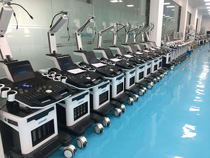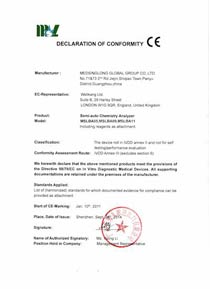MSLRDT004 HBsAg Rapid Test Dipstick for Sale
1. Fast
2. High sensitivity and specificity
3. Simple to use.
4. Accurate and reliable.
5. Ambient storage.
|
Catalog No.
|
MSLRDT004
|
|
Product name
|
HbsAg Rapid Test Dipstick (Whole Blood/Serum/Plasma)
|
|
Analyte
|
Hepatitis B Surface Antigen
|
|
Test method
|
Colloidal Gold
|
|
Sample type
|
WB/Serum/Plasma
|
|
Sample volume
|
3 drops
|
|
Reading time
|
15 mins
|
|
Sensitivity
|
>99.9%
|
|
Specificity
|
Serum/Plasma:99.6%
WB: 99.5%
|
|
Storage
|
2~30℃
|
|
Shelf life
|
24 months
|
|
Qualification
|
/
|
|
Format
|
Strip
|
|
Package
|
50T/kit
|

MSLRDT004 HBsAg Rapid Test Dipstick for Sale
The HBsAg Rapid Test Dipstick is a rapid chromatographic immunoassay for the qualitative detection of Hepatitis B Surface Antigen in whole blood, serum or plasma.
Viral hepatitis is a systemic disease primarily involving the liver. Most cases of acute viral hepatitis
are caused by Hepatitis A virus, Hepatitis B virus (HBV) or Hepatitis C virus. The complex antigen
found on the surface of HBV is called HBsAg. Previous designations included the Australia or Au
antigen. The presence of HBsAg in whole blood, serum or plasma is an indication of an active
Hepatitis B infection, either acute or chronic. In a typical Hepatitis B infection, HBsAg will be
detected 2 to 4 weeks before the ALT level becomes abnormal and 3 to 5 weeks before symptoms
or jaundice develop. HBsAg has four principal subtypes: adw, ayw, adr and ayr. Because of
antigenic heterogeneity of the determinant, there are 10 major serotypes of Hepatitis B virus.
The HBsAg Rapid Test Dipstick is a rapid test to qualitatively detect the presence of HBsAg in
whole blood, serum or plasma specimen. The test utilizes a combination of monoclonal and
polyclonal antibodies to selectively detect elevated levels of HBsAg in whole blood, serum or
plasma.
MSLRDT004 HBsAg Rapid Test Dipstick for Sale
The HBsAg Rapid Test Dipstick is a qualitative, solid phase, two-site sandwich immunoassay for
the detection of HBsAg in whole blood, serum or plasma. The membrane is pre-coated with
anti-HBsAg antibodies on the test line region of the Dipstick. During testing, the whole blood,
serum or plasma specimen reacts with the particle coated with anti-HBsAg antibodies. The
mixture migrates upward on the membrane chromatographically by capillary action to react with
anti-HBsAg antibodies on the membrane and generate a colored line. The presence of this
colored line in the test region indicates a positive result, while its absence indicates a negative
result. To serve as a procedural control, a colored line will always appear in the control line region
indicating that proper volume of specimen has been added and membrane wicking has occurred.
【REAGENTS】
The test Dipstick contains anti-HBsAg particles and anti-HBsAg coated on the membrane.
MSL TEAM picture


MSL Certificate
MSL Medical cooperate with DHL,FEDEX,UPS,EMS,TNT,etc.International shipping company,make your goods arrive destination safely and quickly.





 Price is 8-20% Lower Than Other
Price is 8-20% Lower Than Other














![{pr0int $v['title']/}](https://medicalequipment-msl.com/upload/img/20180522/201805221842185093.jpg.jpg)
![{pr0int $v['title']/}](https://medicalequipment-msl.com/upload/img/20180104/201801041722259316.jpg.jpg)
![{pr0int $v['title']/}](https://medicalequipment-msl.com/upload/img/20180105/201801051008471506.jpg.jpg)
![{pr0int $v['title']/}](https://medicalequipment-msl.com/upload/img/20180104/201801041743356476.jpg.jpg)
![{pr0int $v['title']/}](https://medicalequipment-msl.com/upload/img/20180105/201801050937087001.jpg.jpg)
![{pr0int $v['title']/}](https://medicalequipment-msl.com/upload/img/20180105/201801050937098646.jpg.jpg)
![{pr0int $v['title']/}](https://medicalequipment-msl.com/upload/img/20180104/20180104151925823.jpg.jpg)
![{pr0int $v['title']/}](https://medicalequipment-msl.com/upload/img/20180104/201801041722253617.jpg.jpg)
![{pr0int $v['title']/}](https://medicalequipment-msl.com/upload/img/20180522/201805221832489592.jpg.jpg)
![{pr0int $v['title']/}](https://medicalequipment-msl.com/upload/img/20180104/201801041743355792.jpg.jpg)
![{pr0int $v['title']/}](https://medicalequipment-msl.com/upload/img/20180105/201801051008472478.jpg.jpg)
![{pr0int $v['title']/}](https://medicalequipment-msl.com/upload/img/20180104/201801041722257608.jpg.jpg)
![{pr0int $v['title']/}](https://medicalequipment-msl.com/upload/img/20180105/201801050937095861.jpg.jpg)
![{pr0int $v['title']/}](https://medicalequipment-msl.com/upload/img/20180104/201801041743356059.jpg.jpg)
![{pr0int $v['title']/}](https://medicalequipment-msl.com/upload/img/20180104/201801041519256624.jpg.jpg)
![{pr0int $v['title']/}](https://medicalequipment-msl.com/upload/img/20180104/201801041519253116.jpg.jpg)
![{pr0int $v['title']/}](https://medicalequipment-msl.com/upload/img/20180111/201801111705377686.jpg.jpg)
![{pr0int $v['title']/}](https://medicalequipment-msl.com/upload/img/20180105/201801051008478805.jpg.jpg)
![{pr0int $v['title']/}](https://medicalequipment-msl.com/upload/img/20180614/201806141752243474.jpg.jpg)
![{pr0int $v['title']/}](https://medicalequipment-msl.com/upload/img/20200412/202004122124098335.jpg.jpg)


